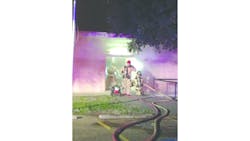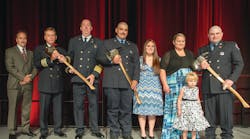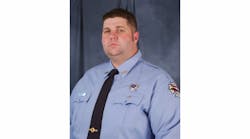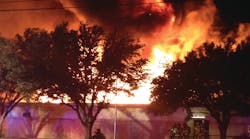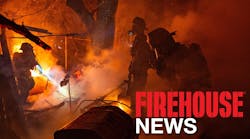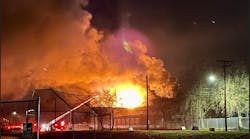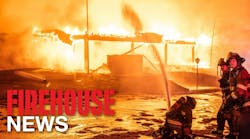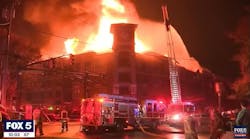This is the final installment in a multi-part series about a fire that took the lives of two Bryan, TX, Fire Department (BFD) lieutenants and critically injured two firefighters in February 2013.
The following comments from Chief Goldfeder are based on discussions with personnel of the BFD, including Chief Randy McGregor, as well as facts from the National Institute for Occupational Safety and Health (NIOSH) and Texas State Fire Marshal reports (these comments and discussion points may have direct, varied or little relationship to the factors of this fire; however, they should be considered applicable to ensure the survival of all personnel on the fireground):
The members of the BFD, along with family members and friends, have been through hell. They have been investigated, evaluated and interviewed – which is what any department must expect at anytime, but certainly following a catastrophic incident and related losses.
The BFD will not be the same as it was prior to that February evening in 2013. In some respects, the pain will always be there, as they, their families and friends will never forget. On the other hand, when a loss like this happens, one of the most critical things a department and their leaders can do is to learn from it – and share what they have learned – so they and we honor the loss of Lieutenant Greg Pickard and Lieutenant Eric Wallace. When learn from those who have gone before us, we honor their lives and their sacrifice in the highest means possible. When we learn from them, their loss is never in vain.
At this fire, several contributing factors led to the severely injured surviving firefighters and the fallen firefighters. Here are some for discussion:
• The building was not sprinklered. Simply put, fire sprinklers save lives (of civilians and firefighters) as well as property. Unfortunately, for a variety of reasons (mostly being political and fiscal-driven greed by some in the building industry), across the United States and Canada, most buildings are not sprinklered. If this building were sprinklered, you would be reading something else now.
• Size-up/risk versus gain. Sometimes, when we pull up on a reported fire and we perform a size-up, it is obvious we should not enter, such as when the structure is fully involved (what I mean by fully involved is that there is fire everywhere; otherwise, it is not fully involved). Sometimes, it is obvious we should go in, which really is the case most times, when conditions indicate we should do so. Either way, size-up helps us make those initial and on-going determinations.
In this case, the initial decision, based on their initial observations, was to enter and size-up the interior conditions. Remember, the building was closed and there were no cars anywhere, so all obvious size-up indications were that it was unoccupied at the time of the fire. The initial reason to enter was to identify the fire conditions and get water on it quickly and, if on the off chance that there were victims, they may have been located.
• Do you know ROE? Fire departments should be aware of the International Association of Fire Chiefs (IAFC) Safety, Health and Survival Section’s Rules of Engagement (ROE) of Structural Firefighting. These guidelines recommend that incident commanders conduct or obtain a 360-degree situational incident size-up, determine the occupant survival profile and conduct an initial risk assessment. The ROE is available at www.IAFCSafety.org.
• Fireground strategy and communications. It was clear from the start that the decision was to make this an offensive fire. The “game plan” was communicated clearly by Lieutenant Wallace, and that was the right initial decision. As time goes on – seconds and minutes – it is up to command to determine the game plan from there on out. Are things getting better (they were under that impression) or are they getting worse? As an incident commander, you own this. Period. Be it a fire in a trash can, a nursing home, a dwelling or whatever the emergency, when you establish or assume command, you are assuming and accepting full and complete “ownership” of the scene.
Normally, incidents go well and very quickly – and everyone goes home. Sometimes, as an interior officer, you will however find yourself in “command conflict” with the incident commander. In other words, what you see and what command sees may not match – and that’s great; that’s why you are both there. One of the most critical “communicating” jobs the interior officer(s) must do is to identify:
CONDITIONS
ACTIONS
NEEDS
What are the conditions you observe right now? What action have you and are you taking? What do you need? That’s called a CAN report, or a UCAN report (add the unit number in there). Make sure command has a clear understanding of what changes have occurred, especially negative changes.
As a commander, you may find yourself not liking how things are going. So what do you do? You take the information you have right now and take action. Sometimes, that action is to pull your members out. Other times, it may be to redirect them. And still other times, it may be to keep them interior and add more companies. It all depends on conditions, your plan and your resources available to carry out that plan.
What does this really mean? It means there will be times when the “troops” may not “like” what you decide, especially when you decide it’s time to pull them out when conditions are changing. But your decision is based upon what they report, what you observe and your immediate “equation/determination” of those factors.
You may give the order for companies to pull out and some companies may not “like” that. This isn’t about what they like or don’t like. When you make a decision, that decision is to be followed. We can all talk about it later. And that’s a good thing – when we are all here to talk about it, after the fire.
Simply put, at the command level, 10 minutes (see “timing” below) means it is the maximum initial time to re-evaluate and determine whether there is any value in continuing interior operations. When companies are not making progress, there are no lives to be saved or there is conflicting information from interior reports and exterior observations, command should begin the removal of firefighters from the building and transition to a defensive mode. If, after all your training and experience as a commander, you don’t like what you see, fix it, regardless of what that “fix” may be.
At this fire, situation reports and key discoveries were not consistently communicated to command so that fire location, spread, control progress and other vital information could be monitored and factored into the decision-making process. During their movement through the bingo area, Engine 1 twice encountered fire above their heads as well as increasing smoke and heat. Truck 1 saw fire burning through the exterior wall on side B while performing a 360-degree walk-around and encountered heavy fire when they opened the adjacent exterior door to the kitchen. Neither crew reported this to command. This information, combined with reports of heavy fire in the dance hall area reported by Engine 2, could have proven valuable to command in determining that the fire was not localized and was not being controlled at that time.
• Resources. I have used football analogies comparable to the fireground in previous columns – and will now. As a firefighter operating inside, or as the commander operating outside, you never want an empty bench. What I mean is that the next time you watch a game on TV, notice that the coach (the incident commander) and the assistant coaches (divisions) always have a full bench available. The full bench allows for resources just in case things are not going as planned on the field – or your fireground.
It is important that, in addition to a full first-alarm response that matches the fire and tasks your firefighters must perform, that you have enough resources “on the bench” for that backup, relief or emergency conditions. A good time to fill the bench (this is not your rapid intervention team; rather, they are due on your first alarm, the initial dispatch) is when you have indications of a working fire. Multiple reports, police on scene reporting, people reported trapped, etc. – details that make it obvious that your first alarm is going to be busy, so fill the bench. In some areas, they use the term “working fire dispatch” and communications adds two engines and a truck to the scene – to fill the bench automatically – when conditions before or upon arriving at the scene indicate everyone is going to work.
• Rapid fire progression – but where is the fire? At the Knights of Columbus hall, the fire burned and spread undetected above the ceiling. This is not an uncommon occurrence, especially in commercial buildings. The members did not recognize the conditions indicative of two dangerous situations that existed or were developing while operating interior, including that fire was involving concealed spaces above the ceiling and the pre-flashover conditions. They did not initially have a thermal imaging camera with them, which would have likely helped them discover the problems brewing above them.
When I learned about this fire in Bryan, and had a chance to speak with and meet with those involved, the “fire in the ceiling” circumstances reminded me of a 1989 fire that occurred in Orange County, FL. Specifically, it taught me about “hidden” fire above and how quickly conditions can change. Very briefly, early on the morning of Feb. 24, 1989, Orange County Engine 36 was dispatched as a part of the first alarm to a fire in a T-shirt store. Light smoke was showing from the attic area, but the store itself was clear of smoke. Firefighter/Paramedic Mark Benge and Firefighter Richard Marcotte pulled a 1¾-inch hose to the front door and forced entry. Engineer Todd Aldridge, who was acting lieutenant on this shift, ordered Benge to pull ceiling tiles just inside the door to check fire conditions above them. The area was clear, so the crew began advancing deeper into the store. As they did so, Benge kept pulling ceiling tiles, but saw no sign of fire.
Then, all of a sudden, around 10 minutes into the run, the entire roof structure began collapsing into the first floor. Aldridge yelled to his two firefighters to get out. Marcotte was not seriously injured and managed to crawl to the glass door and break his way out with his self-contained breathing apparatus (SCBA) bottle. Rescue attempts were made by additional units that arrived, but the fire flared to life with such intensity the rescue failed. Engineer Todd Aldridge and Firefighter/Paramedic Mark Benge gave the ultimate sacrifice. (For more on this fire, search “Aldridge-Benge Firefighter Safety Act.”)
• Ventilation – understanding the reaction to our or the fire’s action. Companies arriving observed fire coming from the roof at the A/B corner. The truck company “popped” the door at the A/B corner on the B side and saw heavy fire, but did not have a hoseline to attack the fire. Lieutenant Wallace and his probationary firefighter advanced a hoseline through the bingo hall to this same area to attack the fire from the inside. They had not pulled any ceiling tiles and did not have a thermal imager to see if the fire was advancing above them. Additionally, positive-pressure ventilation (PPV) fans were placed at the front door on A side, which allowed better visibility within the vestibule, but in turn negatively pushed outside air into the structure.
• Remembering commercial building versus single-family-dwelling tactics and staffing. At almost every fire department, we respond to single-family-dwelling fires, which means we most often use single-family-dwelling tactics and, typically, room(s) and contents. Commercial fires, often just in size alone, create greater and different challenges.
The fire in this 7,400-square-foot, wood building had vented through the roof, which was observed by 9-1-1 callers before the first company arrived on scene. Command and front-line officers need to take this information into account and be aware that the fire may be free-burning – potentially above an interior operation, as it was in this incident.
• Crew integrity. Lieutenant Wallace and his probationary firefighter became separated after leaving together. One assumption is that Lieutenant Wallace followed the line out, but the line had a loop in it, and he followed it back to his nozzle while his firefighter was able to get out. The firefighter was unaware that his lieutenant was having trouble exiting until after he heard a transmission over the radio. By this time, the two were out of reach and contact from each other. Lieutenant Wallace immediately began radioing for assistance and alerted others by depressing his emergency button on his hand-held radio.
• Air management and timing. During operations, Lieutenant Wallace asked his probationary firefighter to check his remote pressure gauge for him to see how much air he had remaining. According to information from the BFD lieutenant coming off shift, there was an issue with Lieutenant Wallace’s self-contained breathing apparatus (SCBA) heads-up display, but the SCBA remained in service. After determining how much air he had left, approximately one-quarter, or 25%, Lieutenant Wallace made the decision that he and his probationary firefighter would exit the building, but the lieutenant became separated from his probationary firefighter and then had difficulty in following the hoseline to the exit.
The remaining air in his bottle was not sufficient for Lieutenant Wallace to attempt to follow the hoseline out before becoming disoriented. He suffered an SCBA emergency and may have been out of air when the RIT found him. It is not known whether he removed his own facepiece, but it was not on when he was brought out of the structure.
Time can so easily get away from us while operating; however, systems can be put in place to help us manage that. Does your fire department use a system in which dispatch alerts command that they are “10 minutes” into the incident, and then again at “20 minutes” into the incident, etc?
Every 10 minutes makes good sense from a command-level overall air-management standpoint. Why 10 minutes? It allows for approximate exit time for the members operating. When a low-air alarm sounds, many departments now consider that situation a Mayday emergency. The idea is to operate within your known air-usage time and (you and your crew) be out before the low-air alarm sounds.
• Mayday, radios, fireground emergencies and dispatch. While Lieutenant Wallace did report his emergency, he did not declare “Mayday.” He did transmit to the incident commander that he needed assistance and he did activate the emergency button on his hand-held radio. However, he was unable to reset it (locking the channel with his mic auto-keyed), which might have caused communications problems on the fireground between firefighters on this channel. Dispatch or the incident commander should request an additional tactical channel when a firefighter issues a Mayday or is in trouble to handle the fireground operations.
Also, the International Association of Fire Fighters (IAFF) Fireground Survival program, which is available to all fire departments, career or volunteer, was developed to ensure that training for Mayday prevention and Mayday operations is consistent between all firefighters, company officers and chief officers. Here is that program: http://www.iaff.org/HS/FGS/FGSIndex.htm
Now is a good time to determine what your fire department’s Mayday procedure is. What happens to the fireground companies not involved with the Mayday? What resources automatically respond upon the transmission of a Mayday? How is EMS handled? What role does dispatch play? How simple is the policy? Simple enough to know it immediately when you hear Mayday?
While we often discuss staffing on the fireground, we often forget there is a need to staff at the command level. At this fire, the commander was managing arriving units from the automatic-aid department and current operations on the fireground when Lieutenant Wallace gave his distress call. The chief now had to manage the RIT operations, deteriorating fire conditions and fireground operations. A chief’s aide would have been valuable in managing the tactical worksheet, maintaining personnel accountability of all members operating at the incident and monitoring radio communications.
• SCBA policy related to inspection and reporting of problems. Prior to the incident, Lieutenant Wallace was advised by the lieutenant coming off shift that the officer’s SCBA heads-up display was not functioning. This event actually occurred after shift change because an earlier fire had begun shortly before Lieutenant Wallace came on duty at 7 A.M. and the lieutenant who was going off noted the problem while at this fire, which started at around 6:30 A.M.
Lieutenant Wallace used this same SCBA during the incident. His heads-up display wasn’t working, so he was not able to determine how much air remained in his SCBA bottle. When he asked his probationary firefighter to look at his remote pressure gauge, it was discovered that the lieutenant had only 25% of air remaining. This proved not to be enough air for him to follow the hoseline out before getting separated and disorientated. More than 15 minutes passed after he made his final transmission and he was removed from the structure.
• Hoselines – what and where? Anytime you are operating inside, you should always be able to answer this question: Where is the hoseline (or backup line) that is protecting you? During this fire, a second hoseline was initially stretched into the structure by Engine 2 to back up the Engine 1 crew. When it was determined that the Engine crew was OK, the Engine 2 crew repositioned that second line for firefighting support from the vestibule into the dance hall. At this point, both hoselines were being used for primary firefighting in two different locations, but the crews and the primary egress point were not protected by additional hoselines.
Calculate the need before the fire and create first-alarm assignments based on the needed tasks. Include the staffing of your department and mutual aid departments, as some may arrive with three or four firefighters, but others may arrive with fewer firefighters. When arriving with fewer firefighters, it takes longer to accomplish tasks.
In conclusion, please read the NIOSH and Texas State Fire Marshal reports on the Knight of Columbus Hall fire in Bryan. It is critical for you to fully understand what these members went through and, in some cases, what they are still going through.
Lieutenant Wallace experienced something none of us ever want to experience. Lieutenant Pickard gave his life attempting to save his brother firefighter. Firefighters Rickey Mantey and Mitch Moran suffered extreme burns assisting in those life-saving attempts and the families, the BFD members and friends have also experienced life-altering events – from deaths to physical injury to the emotional and mental aspect.
While we honor those who performed so heroically, we also want to learn so that we can minimize similar future incidents from occurring. By learning from what the BFD went through, we can no better honor Lieutenants Pickard and Wallace. RIP.
